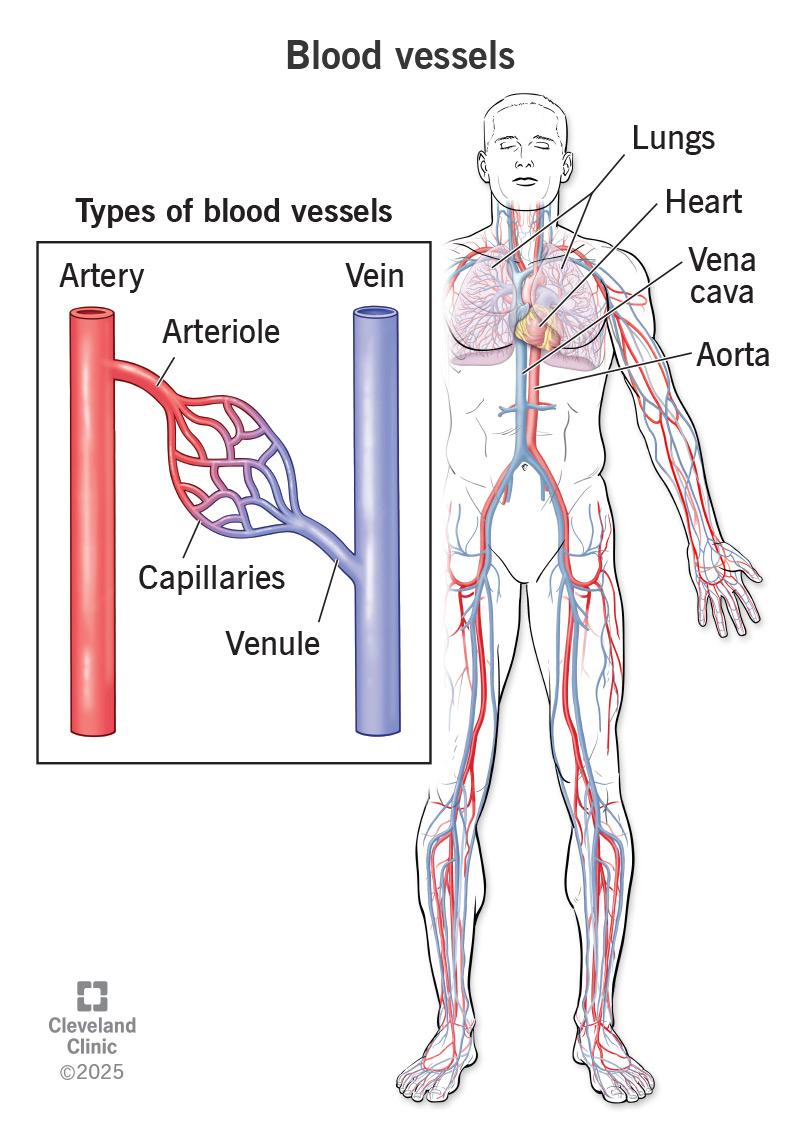Blood vessels circulate blood throughout your body. They help deliver oxygen to vital organs and tissues, and also remove waste products. They regulate your blood pressure, as well. Blood vessels include veins, arteries and capillaries. Each type serves a purpose in your body.
Advertisement
Cleveland Clinic is a non-profit academic medical center. Advertising on our site helps support our mission. We do not endorse non-Cleveland Clinic products or services. Policy

Blood vessels are channels that carry blood throughout your body. They form a closed loop, like a circuit, that begins and ends at your heart. Together, your heart and blood vessels form your circulatory system. Your body contains about 60,000 miles of blood vessels.
Advertisement
Cleveland Clinic is a non-profit academic medical center. Advertising on our site helps support our mission. We do not endorse non-Cleveland Clinic products or services. Policy
There are three main types of blood vessels:
The function of blood vessels is to deliver blood to the organs and tissues in your body. Blood supplies them with the oxygen and nutrients they need to work. Blood vessels also carry waste products and carbon dioxide away from your organs and tissues.
Each type of blood vessel serves a different function:
Blood vessels run all through your body. Branches from large vessels get smaller and smaller, reaching every organ in your body. You have billions of blood vessels in your body, and most of them are capillaries, venules and arterioles. These smaller vessels connect to 160 arteries and 200 veins.
Advertisement
Your most important blood vessel is your body’s main artery — your aorta. This is a large artery that carries blood away from your heart and delivers oxygen-rich blood to your body. Your aorta runs down through your chest, diaphragm and abdomen (belly), branching off in many areas. Near your pelvis, this main artery branches into two arteries that supply blood to your lower body and legs.
The main vein in your body is the vena cava. The superior vena cava is in the upper right part of your chest. It takes blood from your head, neck, arms and chest back to your heart. The inferior vena cava is near the right side of your diaphragm. It brings blood from your legs, feet, abdomen and pelvis back to your heart.
Blood vessel anatomy includes three layers of tissue:
Blood vessels have a tube-like shape, but they rarely run in a straight line. Some are big enough to see under your skin. If you’ve ever had your blood drawn, you may have noticed veins on the inside of your arm. They might appear blue under your skin, even though your blood is red.
Many different problems can affect your blood vessels, including:
Advertisement
Symptoms vary widely across the different types of blood vessel disorders. Some, like aneurysms or vascular malformations, may not cause symptoms until a serious problem develops.
In general, it’s a good idea to talk to a healthcare provider if you experience:
Seek immediate medical attention if you experience:
There are a variety of ways you can improve the health of your blood vessels, including:
Blood vessels carry blood throughout your body. They’re essential for making sure your organs and tissues get the oxygen and nutrients they need to work. But blood vessels can develop problems, like blockages or enlargement. Severe blood vessel disorders can be life-threatening. You can keep your blood vessels in good shape by having healthy habits.
Advertisement
Cleveland Clinic’s primary care providers offer lifelong medical care. From sinus infections and high blood pressure to preventive screening, we’re here for you.

Last reviewed on 02/12/2025.
Learn more about the Health Library and our editorial process.